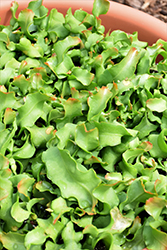>> Home
Orchid Catcus
Epiphyllum guatemalense var. monstrose
Height: 3 feet
Spread: 3 feet
Sunlight:
![]()
![]()
Other Names: Curly Locks, Curly Sue, Curly Orchid Cactus
Description:
Beautiful long, cascading green succulent stems twist and curl, creating a beautiful display in hanging baskets and containers; produces large, 3" wide fragrant blooms that open at night; easy to grow and low maintenance
Features & Attributes
Orchid Catcus is a succulent evergreen plant. It is an atypical member of the cactus family known as an 'epiphyte' or 'air plant', which means that it doesn't necessarily require a growing medium for its roots. Like all other cacti, it doesn't actually have leaves, but rather modified succulent stems that comprise the bulk of the plant. This particular variety of cactus is valued for its characteristically trailing and weeping form on a plant consisting of long and flattened smooth lime green segmented stems that typically form 'branches' which will grow outwards and even spill over the edges of containers. This plant features showy lightly-scented white daisy flowers along the stems from mid spring to mid summer, which emerge from distinctive pink flower buds.
Planting & Growing
When grown indoors, Orchid Catcus can be expected to grow to be about 3 feet tall at maturity, with a spread of 3 feet. It grows at a medium rate, and under ideal conditions can be expected to live for approximately 10 years. This houseplant performs well in both bright or indirect sunlight and strong artificial light, and can therefore be situated in almost any well-lit room or location. This is a unique plant in that it requires extremely dry, well-drained soil, and it will die if left in standing water for any length of time - in fact it will suffer if it is over-watered. The soil should be allowed to go completely dry to the touch an inch or two deep for prolonged periods, and it may only need watering once every few weeks. Be aware that your particular watering schedule may vary depending on its location in the room, the pot size, plant size and other conditions; if in doubt, ask one of our experts in the store for advice. Like most succulents and cacti, it prefers to grow in poor soils and should therefore never be fertilized. It is not particular as to soil type or pH; an average potting soil should work just fine. Be warned that parts of this plant are known to be toxic to humans and animals, so special care should be exercised if growing it around children and pets.
There are many factors that will affect the ultimate height, spread and overall performance of a plant when grown indoors; among them, the size of the pot it's growing in, the amount of light it receives, watering frequency, the pruning regimen and repotting schedule. Use the information described here as a guideline only; individual performance can and will vary. Please contact the store to speak with one of our experts if you are interested in further details concerning recommendations on pot size, watering, pruning, repotting, etc.
-- THIS IS A HOUSEPLANT AND IS NOT MEANT TO SURVIVE THE WINTER OUTDOORS IN OUR CLIMATE --
